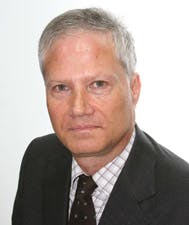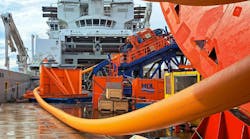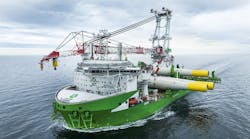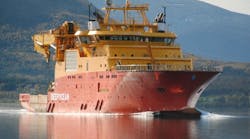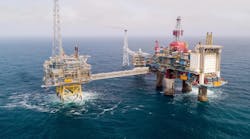UK development revival lifts production
Provisional data from Britain's Department of Energy and Climate Change (DECC) suggests UK offshore production is increasing for the first time in 15 years. Output across the shelf for the first half of 2015 was up by 2.5% compared with the same period in 2014.
Industry association Oil & Gas UK said the improvement was partly due to growing volumes from the Nexen-operated Golden Eagle project in the UK central North Sea, which started up last fall. Improved performance from other fields may be another factor, reflecting the industry's heavy investment in recent years in prolonging the integrity of UK production facilities.
Output should continue to rise as more new projects come onstream in the next few months, including Premier Oil's Solan and Total's Laggan/Tormore projects near the Shetland Islands; EnQuest's Alma/Galia in the UK central North Sea; and GDF Suez E&P UK's Cygnus in the southern gas basin.
Here Seaway Heavy Lifting's crane vessel Oleg Strashnov recently installed the process unit (PU) platform topsides, in the process establishing a new lift record for the contractor with a hook load of 4,700 metric tons (5,181 tons). Earlier, the Heerema Hartlepool yard in northeast England delivered the compression module for the Cygnus Alpha platform, the last of the main structures the yard has built for the four-platform complex. At Methil on Scotland's east coast, Burntisland Fabrications completed its fourth and final jacket for the field, for the Bravo platform.
Larger-scale projects should come onstream in the Shetlands area over the next two years, namely BP's Clair Phase 2 (Clair Ridge) and Quad 204 redevelopment, and Statoil's Mariner. The 22,400-ton jacket for the Mariner platform - the biggest jacket ever built by Dragados Offshore at its yard in Cadiz, southwest Spain - was due to be launched and installed at the field location last month.
Latest UK license round completed
Britain's new Oil & Gas Authority has issued 41 new licenses following additional environmental assessment and consultations under the 28th Offshore Licensing Round. This lifts the total number of UK offshore licenses awarded since the first batch late last year to 175, spanning 353 blocks.
The latest awards include frontier acreage in the Rockall Trough off western Scotland, where the government has pledged support for 2D seismic acquisition, and the St George's Channel basin separating the southwest UK and southeast Ireland. Licensees range from experienced operators to relative newcomers, said Oil & Gas UK operations director Oonagh Werngren. While welcoming the response to the round, she expressed concern that the latest awards carried commitments to only one firm well and five new 3D seismic campaigns, with most of the licenses conferred on the basis of reprocessing or securing old 2D and 3D data.
Among the frontier award winners were Hurricane Energy, which picked up blocks 204/30b and 205/26d close to its basement Lancaster oil discovery in the West of Shetland region. The blocks include the potentially analogous Warwick structure and a possible extension of the Lincoln prospect. Hurricane has been working with Schlumberger on a full-field simulation model of Lancaster's reservoir, based partly on analysis of last year's 1-km (0.6-mi) horizontal appraisal well. They have concluded that a phased development could be commercial, initially via an early production system.
The Faroe Islands government intends to stage the country's fourth Exploration Round in 2017. Despite the modest results from the nine offshore exploration wells drilled over the past 15 years and the recent license relinquishments, the government maintains the subsoil around the islands is oil-prone and underexplored. The Faroes' current Open Door license application procedure will remain closed until after the new round is launched.
Survey to clarify western Ireland potential
Searcher Seismic and Russian geophysical contractor MAGE have completed the Echidna Regional Broadband 2D seismic survey over the Porcupine and Slyne basins and the Goban Spur offshore western Ireland. The 9,100-km (5,654-mi) program is said to be the first authentically regional, long-offset well tie survey over the Irish continental shelf to employ modern processing and acquisition techniques. Fasttrack pre-stack time migration data should be available for the planned opening of Ireland's 2015 Atlantic Margin bid round this month.
Jan Gunnar Opsal, Searcher's Norway country manager, said the survey ties in 30 exploratory and appraisal wells, around 80% of the total drilled in the area. "The rift systems associated with these basins are among the most interesting exploration targets in the North Atlantic," he added.
Statoil reports second find in King Lear area
Statoil and Total have discovered gas and condensate in the high-pressure/high-temperature Julius prospect close to the undeveloped King Lear field in the southern Norwegian North Sea. Recoverable volumes appear to be in the 15-75 MMboe range, confirming Statoil's previous estimate for the King Lear area of 70-200 MMboe.
In the northern Norwegian North Sea, Statoil has started up its latest subsea add-on project, Gullfaks South, designed to produce a further 65 MMboe from the Gullfaks area and extend the life of the Gullfaks A platform beyond 2030. The company sanctioned the NOK 9-billion ($1.09-billion) program three years ago. Statoil says the subsea scope was more complex than some of its previous tieback projects, with a total of 22 subsea tie-ins. Development calls for two subsea templates, four producer wells and two gas injectors with a dedicated gas injection pipeline, along with umbilicals and power cables for pipeline heating.
Lundin Petroleum continues exploration around the Edvard Grieg field in the central Norwegian North Sea, where production should begin this fall. The company's latest well encountered a 66-m (216-ft) oil column at the field's southeastern edge. This area and the Luno II discovery could both be tied in at some point to the Edvard Grieg production platform.
Hibiscus, Ping clinch deal for Anasuria
Shell and ExxonMobil have agreed to terms for their second major UK North Sea asset sale this year. Hibiscus Petroleum and Ping Petroleum will jointly acquire the producing Anasuria cluster of oil and gas fields in the UK central North Sea, subject to the usual consents. The package includes the Anasuria FPSO and associated processing infrastructure, with potential for future tie-ins of nearby accumulations; the Guillemot A, Teal and Teal South fields; and a 38.65% interest in the Cook field. Hibiscus said the transaction was facilitated by the UK government's measures to support smaller independents looking to invest in the UK continental shelf.
In June, Shell/ExxonMobil completed the sale of the Sean gas field and associated platform in the UK southern North Sea to Oranje-Nassau Energie.

